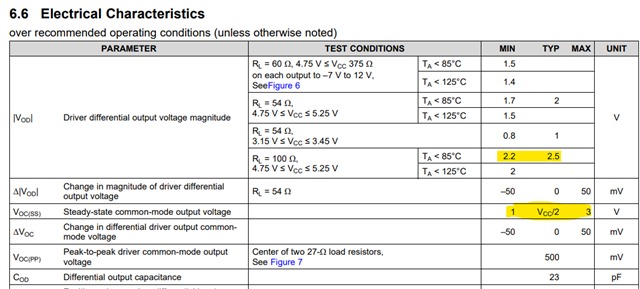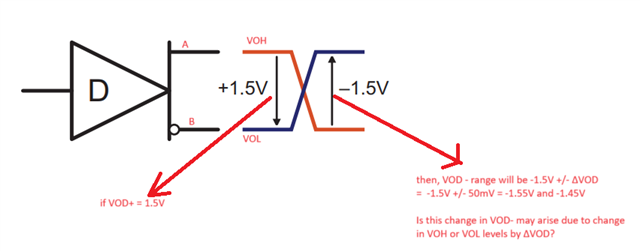Hi,
We are performing worst case analysis. There are some doubts regarding the SN65HVD1782-Q1 specifications. 
1. The levels VOD, VOC(SS) is marked in the below diagram as per our understanding. Is our understanding correct? Does VOD(pp)-nom = 3V calculated correct?
Ref: Communication Module Reference Design for Functional Isolated RS-485, CAN, and I2C Data Transmission (Rev. A)
2. Below is the calculation of worst case VOH_min and VOH_max levels (as represented in above diagram),
VOH_min = VOC(ss)_min + (VOD_min/2) = 1V + (2.2V/2) = 2.1V
and VOH_max = VOC(ss)_max + (VOD_typ/2) = 3V + (2.5V/2) = 4.25V. Here, VOD_typ is used as VOD_max value is unavailable.
But, SN65HVD1782-Q1 is connected to VCC = 3.3V and RL = 120ohms (RS-422). In that case, VOH_max is exceeding 3.3V which looks incorrect. Please confirm whether the spec provided is correct or does this calculation is different for VCC = 3.3V?
The |VOD| spec used in the above calculation is for the condition RL=100ohms and 4.75V < VCC < 5.25V.
3. Does VOC(ss) and |VOD| spec different for VCC = 3.3V and RL = 120ohms? If so, is it possible to get the minimum and maximum values of VOC(ss) and |VOD| for the same or do we need to consider VOC(SS)_min = 1V for minimum VCC = 3.15V and VOC(SS)_max = 3V for maximum VCC = 5.25V and |VOD|_min = 2.2V and |VOD|_max = unavailable for the calculations?
-
Ask a related question
What is a related question?A related question is a question created from another question. When the related question is created, it will be automatically linked to the original question.



